' |
 |
 |
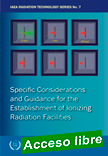 |
Specific Considerations and Guidance for the Establishment of Ionizing Radiation Facilities
Radiation Technology Series No. 7 ¦ STI/PUB/1999 ¦ 85 pages ¦ 5 figures ¦ Date published: 2023
Various nuclear techniques have led to opportunities to enhance quality of life through services offered by ionizing radiation facilities (IRFs). National nuclear institutions, universities, medical centres, and private companies have established and used IRFs not only for research and development purposes but also for the provision of commercial services and goods. This publication provides guidance for organizations and institutions working on IRF projects to enable them to undertake them in a well-organized manner.
|
. It includes considerations for a feasibility study, provides detailed methodologies on how to assess the status of the necessary infrastructure, and aims to help Member States as well as their respective organizations to understand their commitments and obligations associated with an IRF project. It is intended to be used by managers, staff, decision makers at the national level and other stakeholders at institutions that are seeking or supporting the establishment of an IRF.
|
 |
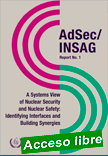 |
A Systems View of Nuclear Security and Nuclear Safety: Identifying Interfaces and Building Synergies
STI/PUB/2037 ¦ 38 pages ¦ Date published: 2023
Jointly developed by the lAEA Advisory Group on Nuclear Security (AdSec) and the International Nuclear Safety Group (INSAG), this publication examines the commonalities and differences of nuclear security and nuclear safety, with a view to stimulating new thinking on how the common elements of nuclear security and nuclear safety can be further recognized to enhance excellence in the management of nuclear activities.
|
Although safety and security have a somewhat different focus, they may overlap with each other and have a common goal – protecting people and society. Actions taken to further one activity can have implications for the other. This publication, written for professionals working in the area, focuses on the interfaces between nuclear safety and security with the aim of ensuring that safety and security actions are integrated with each other as appropriate and serve to reinforce each other. It seeks to establish a framework for a more holistic capability to further both safety and security.
|
 |
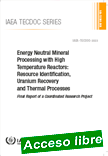 |
Energy Neutral Mineral Processing with High Temperature Reactors: Resource Identification, Uranium Recovery and Thermal Processes
IAEA-TECDOC-2023¦ 158 pages ¦ 77 figures ¦ Date published: 2023
With easily extractable resources depleting rapidly, global production of uranium is moving to lower-grade and presently considered unconventional resources that can contain relevant amounts of naturally occurring uranium: Processing these resources can require large amounts of energy that could be provided reliably by small modular reactors (SMRs).
|
This publication reports on the findings of an IAEA Coordinated Research Project (CRP) which investigated the use of SMRs for energy neutral mineral processing. It summarizes the results of the CRP and includes 12 case studies conducted by the participating Member States. It is intended to inform future decision makers and other stakeholders.
|
 |
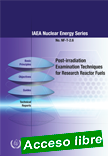 |
Post-irradiation Examination Techniques for Research Reactor Fuels
IAEA Nuclear Energy Series No. NF-T-2.6 ¦ STI/PUB/1934 ¦ 104 pages ¦ 118 figures ¦ Date published: 2023
Post-irradiation examination (PIE) is an indispensable step in the selection of new or improved research reactor fuel, and in the characterization and understanding of its in-core behaviour. This publication provides an introduction to PIE techniques. It describes a typical PIE process from intercycle inspections in the reactor pool or channel, to hot cell PIE, which is subdivided into non-destructive and destructive testing techniques with their typical output, advantages and drawbacks, and their applicability to understanding fuel irradiation behaviour.
|
Much of the work presented in this publication originated from the research and development of new low enriched uranium research reactor fuels. Intended readers include research reactor operators, regulators and their technical support organizations, fuel developers and manufacturers, laboratory staff, and policy makers.
|
 |
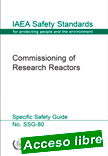 |
Commissioning of Research Reactors
IAEA Safety Standards Series No. SSG-80 ¦ Specific Safety Guides STI/PUB/2039 ¦ 63 pages ¦ Date published: 2023
This Safety Guide provides specific recommendations on establishing a programme and organization for commissioning of research reactors to meet the relevant requirements of IAEA Safety Standards Series No. SSR-3, Safety of Research Reactors. It covers the commissioning stages, procedures, reports and documentation and provides guidance for commissioning of new experimental devices and modifications.
|
The recommendations in this publication are intended for use by operating organizations of research reactors, regulatory bodies and other relevant organizations involved in a research reactor project. This Safety Guide is a revision of IAEA Safety Standards Series No. NS-G-4.1, which it supersedes.
|
 |
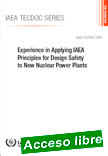 |
Experience in Applying IAEA Principles for Design Safety to New Nuclear Power Plants
IAEA-TECDOC-2021 ¦ 146 pages ¦ 5 figures ¦ Date published: 2023
This publication has been written to assist in developing a common understanding of practices in Member States in the consideration of requirements introduced by IAEA Safety Standards Series No. SSR-2/1, Safety of Nuclear Power Plants: Design and the supporting safety guides, for the design and safety assessment of new nuclear power plants.
|
Member States' experience in the consideration of IAEA requirements for the design and safety demonstration of new nuclear power plants has been collected, in order to highlight common approaches and to capture potential differences pertaining to the interpretation of the requirements or in their implementation in the design of new nuclear power plants. It will be of use to regulators and all stakeholders involved in the design and safety assessment of new nuclear power plants.
|
 |
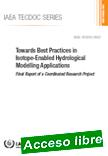 |
Towards Best Practices in Isotope-Enabled Hydrological Modelling Applications
IAEA-TECDOC-2022 ¦ 52 pages ¦ 13 figures ¦ Date published: 2023
Recognizing the importance for adaptation to the climate change impact on water resources, the IAEA has developed guidelines and recommendations on the selection and application of isotope-enabled hydrological models, which can enhance the predictive power of modelling catchment systems for hydrological forecasting, as well as support more realistic water flux and storage simulations of the natural environment.
|
This publication is designed to support modellers and water managers interested in isotope-enabled modelling. It was developed by isotope hydrologists, data network and modelling specialists from different countries, what shared a unique experience on model selection, modelling objectives, data collection and modelling procedure. Examples of their isotope modelling applications have been provided to give context to the guidelines and recommendations made by this publication, where these examples highlight the versatility of isotopes across a range of different environmental and climate settings. Lessons learned from application of isotope-enabled modelling techniques in each of the diverse climate and water settings are discussed.
|
 |
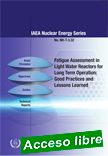 |
Fatigue Assessment in Light Water Reactors for Long Term Operation: Good Practices and Lessons Learned
IAEA Nuclear Energy Series No. NR-T-3.32 STI/PUB/2017 ¦ 156 pages ¦ 86 figures ¦ Date published: 2023
Fatigue is a major element in time limited ageing analysis for long term operation of nuclear power plants (NPPs). It is important to understand how cracks occur and grow as a result of fatigue, and then assess fatigue failure. In the design and operating phase of NPPs, it is essential to consider the concurrent loadings associated with the design transients, thermal stratification, seismically induced stress cycles, and all relevant loads due to the various operational modes.
|
After repeated cyclic loading, crack initiation can occur at the most highly affected locations if sufficient localized micro-structural damage has accumulated. This publication provides practical guidelines on how to identify and manage fatigue issues in NPPs. It explains the mechanism of fatigue, identifies which elements are the major contributors, and details how fatigue can be minimized in the design phase for new NPPs.
|
 |
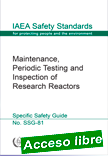 |
Maintenance, Periodic Testing and Inspection of Research Reactors
IAEA Safety Standards Series No. SSG-81 STI/PUB/2044 ¦ 67 pages ¦ Date published: 2023
This Safety Guide provides specific recommendations on the maintenance, periodic testing and inspection of research reactors to meet the relevant requirements of IAEA Safety Standards Series No. SSR-3, Safety of Research Reactors. It provides guidance on design considerations and recommends good practices in implementing the programme and establishing the organization and responsibilities for maintenance, periodic testing and inspection as well as for the selection, training and qualification of personnel.
|
Procedures, administrative controls and maintenance facilities are also covered as well as procurement and storage of spare parts and components, and testing and inspection methods and techniques used for maintenance, periodic testing and inspection. The recommendations provided in this Safety Guide are aimed at operating organizations of research reactors, regulatory bodies and other organizations involved in a research reactor project. This Safety Guide is a revision of IAEA Safety Standards Series No. NS-G-4.2, which it supersedes.
|
 |
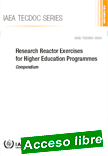 |
Research Reactor Exercises for Higher Education Programmes
English IAEA-TECDOC-2024 ¦ 158 pages ¦ 24 figures ¦ Date published: 2023
Providing a comprehensive overview of the utilization of research reactors for education purposes in an academic environment, this compendium is intended to provide practical guidelines for the development of research reactor exercises to be integrated into education programmes in nuclear science and technology.
|
It will prove useful to all Member States developing nuclear capacity building for existing and new national research reactor programmes. Member States planning to embark on both a research reactor programme and a nuclear power programme, may refer to this publication to ensure that the approach and methodology for the implementation of both programmes is harmonized, efficient and effective from the perspective of capacity building development.
|
 |
| |
|
|

|
|
|
| |
|
|
| |
| |
|
|
| |
| |
|
|
| |
| |
|
|
|
| |
| |
